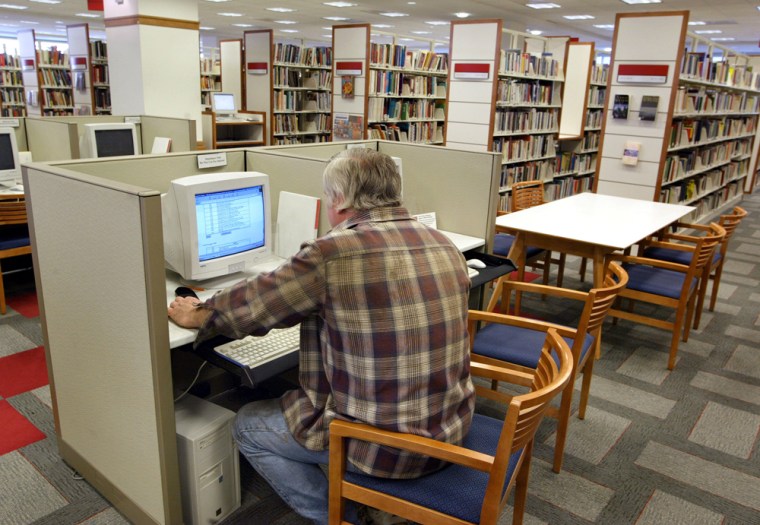YouTube, online job applications and homework help sites have boosted demand and contributed to lines for Internet access at the nation’s public libraries, yet a new survey finds the majority have no immediate plans to add computers.
For many library systems, the buildings simply do not have enough room, and their electrical wiring couldn’t deliver the required power. Others are already struggling to stay open, buy books and encourage youths to read.
“We have this entirely brand new service coming to libraries, but the funding has not recognized that,” said Kathleen Reif, director of the St. Mary’s County Library in Leonardtown, Md. “We’re still continuing the books, the outreach, the work with young children and the student support.”
A new study from the American Library Association, released Wednesday, finds the average number of public Internet terminals largely unchanged since 2002, yet only 1 in 5 libraries say they have enough computers to meet demand at all times.
Besides cost, limitations in space, electrical outlets and cabling are cited as the chief factors preventing libraries from buying more computers. Las Vegas officials, for instance, say they reached capacity a few years ago.
“There are times, especially during those peak usage [hours] after school and as people get out of work, that you may have to wait an hour, an hour and a half,” said Robb Morss, deputy director of the Las Vegas-Clark County Library District.
Pressure to meet demand
Meanwhile, three-quarters of the libraries say they are the only source of free Internet access in their communities, increasing pressure on them to meet demand.
“Libraries are a place where books and periodicals are available, but increasingly public libraries are being asked by their patrons to make these information technologies available,” said Greg Shaw, the director of U.S. program advocacy for the Bill & Melinda Gates Foundation, which co-sponsored the study.
Local and county governments remain the chief sources of funding for libraries, but the study found many libraries having to turn to non-tax revenues such as fines and donations to pay for basic technology-related services.
The St. Mary’s system is likely to leave one full-time position unfilled to free up $40,000 to buy an additional 20 computers, Reif said. That means a 50 percent cut in staff available for outreach programs serving youths.
“You’ve got some basic missions that you’re trying to achieve in a community, trying to reach children at birth and trying to get them ready for school, and you have these computers you need to access the world of information,” Reif said. “It’s a very difficult choice you have, to be constantly balancing those needs.”
Can wireless reduce the wait?
Libraries are increasingly turning to wireless networking to help reduce wait. More than 17 percent of libraries say they plan to add wireless capabilities within a year, meaning 71 percent would be allowing patrons to connect through their own laptops and in some cases through loaner machines.
But libraries haven’t always been able to boost the size of their pipes because of cost or availability of high-speed services in the area. More computers sharing the same pipes mean slower speeds, even as Google Inc.’s video-sharing site YouTube and interactive homework help sites like Tutor.com demand more capacity.
“We may be in fact where we were in 2002” when many libraries still had only slower, dial-up access, said Denise Davis, director of the American Library Association’s Office for Research and Statistics. “Just everything is faster and larger files are being moved around.”
Las Vegas is one of the more fortunate systems, serving a growth area with ample revenues. Although it doesn’t have room to add computers, it has money to add bandwidth — something it had to do earlier this year with the growth of interactive sites.
After-school slowdown?
“We were seeing a great slowdown after school,” Morss said. Students “are looking at interactive sites. They are not looking at text-based sites. Everybody who wants their site to be viewed realizes they have to keep up with the competition.”
About half the libraries, however, say their connection speed is inadequate some or all the time. Yet 17 percent say they cannot get anything faster in the region, and another 18 percent say they cannot afford to upgrade.
The survey of 4,027 public libraries, conducted from September 2006 to January 2007, has a margin of sampling error of plus or minus 5 percentage points. The American Library Association conducted it with Florida State University and the Gates foundation, which distributes grants to libraries for new computers and high-speed connections.
The foundation’s Shaw said poorer families are at risk “if the connection speeds ... are not sufficient to take full advantage of what’s available on the Internet, and if there’s an insufficient supply of computers. Those of us who have regular access to computing, whether at home or at work, risk taking for granted that access.”
